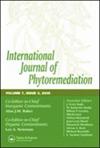更正。
IF 3.4
4区 环境科学与生态学
Q2 ENVIRONMENTAL SCIENCES
International Journal of Phytoremediation
Pub Date : 2025-01-01
Epub Date: 2024-10-11
DOI:10.1080/15226514.2024.2415239
引用次数: 0
摘要
本文章由计算机程序翻译,如有差异,请以英文原文为准。
Correction.
求助全文
通过发布文献求助,成功后即可免费获取论文全文。
去求助
来源期刊
CiteScore
7.60
自引率
5.40%
发文量
145
审稿时长
3.4 months
期刊介绍:
The International Journal of Phytoremediation (IJP) is the first journal devoted to the publication of laboratory and field research describing the use of plant systems to solve environmental problems by enabling the remediation of soil, water, and air quality and by restoring ecosystem services in managed landscapes. Traditional phytoremediation has largely focused on soil and groundwater clean-up of hazardous contaminants. Phytotechnology expands this umbrella to include many of the natural resource management challenges we face in cities, on farms, and other landscapes more integrated with daily public activities. Wetlands that treat wastewater, rain gardens that treat stormwater, poplar tree plantings that contain pollutants, urban tree canopies that treat air pollution, and specialized plants that treat decommissioned mine sites are just a few examples of phytotechnologies.

 求助内容:
求助内容: 应助结果提醒方式:
应助结果提醒方式:


